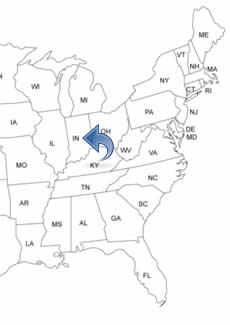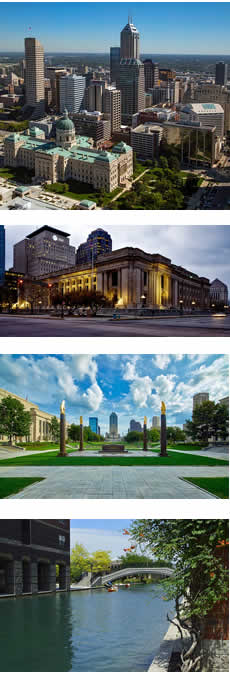INDIANA PEOPLE SEARCH!
- ✔ Contact Info
- ✔ Phone Numbers
- ✔ Criminal Records
- ✔ Income Info
- ✔ Neighbors
- ✔ People's Age
- ✔ Property Ownership
- ✔ And Much More
Indianapolis, Indiana
Indianapolis is located in the central part of Indiana and is the capital and the largest city in the U.S. State of Indiana. The Racing Capital Of The World. Indianapolis is the home of the Indy 500 and Allstate 400 at the Brickyard. The city plays host to numerous conventions and sporting events. Indianapolis is one of the fastest growing regions in the United States.
To See And To Do In Indianapolis
- Museum of Miniature Houses
- National Art Museum of Sports
- The Chase Tower Skyscraper
- White River Gardens
- Soldiers & Sailors Monument
- Children's Museum of Indianapolis
- Indiana War Memorial
- Oldfields-Lilly House & Gardens
- Garfield Park Conservatory and Sunken Garden
- Indianapolis Zoo
- President Benjamin Harrison Home
- Indiana State Museum
- Indianapolis Museum of Contemporary Art
- Indianapolis Museum of Art
- Circle Center Mall
- Indiana Medical History Museum
- Eiteljorg Museum of American Indians and Western Art
- Indiana Historical Society
History Of Indianapolis - Timeline
Around 1800, the place was a swampy region settled by a couple of fur traders who had some log cabin built. Indianapolis was not established by settlers but by proclamation when Indiana was granted statehood in 1816. The city was selected as the site of the new state capital in 1820 and adopted the name of Indianapolis in January, 1821.
In 1822, Indianapolis Gazette was published. In 1825, Indianapolis became the state capital of Indiana. In 1826, the first fire department was founded. In 1832, the town was incorporated. In 1835, the first Statehouse was built. In 1839, the Central Canal on the White River was completed. It was built to provide a transportation link for factories, papermills, and sawmills.
In 1847, Indianapolis was incorporated as a city and on the Madison & Indianapolis Railroad arrived. In 1850, the Indianapolis Business University was established and more than 8,000 people lived in the city. In 1853, the Union Station opened. In 1854, the Indianapolis Police Department was formed. In 1857, the Christ Church Cathedral was built. In 1859, City Hospital was built. In 1861, a prison camp opened. In 1862, Indiana State Museum was established. In 1864, the Indianapolis High School opened.
During the Civil War, Indianapolis was a major railroad hub and transportation center and therefore had military importance. In 1867, the St. John the Evangelist Catholic Church was completed and in 1869, the Bethel A.M.E. Church was completed. In 1880, the English Hotel and Opera House opened.
In 1881, the city installed electric street lighting. In 1888, the Soldiers' and Sailors' Monument was built, and the nation's first illustrated black newspaper, named The Indianapolis Freeman, was printed. Also in 1888, the Indiana Statehouse was completed. In 1893, the Athenæum/Das Deutsche Haus was built.
In 1900, more than 169,000 people lived in the city. In 1901, the 23rd President of the United States "Benjamin Harrison" died in Indianapolis at the age of 67. In 1903, 17 people, including 14 players of the Purdue University football team, were killed in a railroad train collision. (The Purdue Wreck). Also in 1903, the bank robber John Dillinger was born in the city. In 1907, the Saints Peter and Paul Cathedral were completed. In 1909, the Indianapolis Motor Speedway was built and in 1910, the St. Mary's Catholic Church was built.
In 1911, the inaugural Indianapolis 500-Mile Race was held. In 1912, the Arsenal Technical High School was established. In 1913, the Indianapolis Public Library building was completed. In 1916, the Hilbert Circle Theatre was built. In 1923, the jazz guitarist "Wes Montgomery" was born in the city. In 1924, The Indiana World War Memorial Plaza was built. In 1926, The Children's Museum of Indianapolis opened. In 1927, the multiple use performing arts venue, the Indiana Theatre, was built, and the Scottish Rite Cathedral was completed.
In 1930, Indianapolis Symphony Orchestra was founded by the violin professor Ferdinand Schaefer. In 1947, the television host and comedian "David Letterman" was born in the city. In 1958, the Grammy Award-winning R&B musician, singer-songwriter and record producer, Kenneth "Babyface" Edmonds, was born in the city. In 1964, the Indianapolis Zoo opened.
In 1968, Robert F. Kennedy's speech on the assassination of Martin Luther King, Jr. was given in the city. In 1970, the 36-story building "One Indiana Square" was completed. In 1975, the Indianapolis International Airport opened. In 1984, the RCA Dome/Hoosier Dome opened. In 1990, the Chase Tower was completed. In 2008, the multi-purpose sports stadium "Lucas Oil Stadium" opened.

